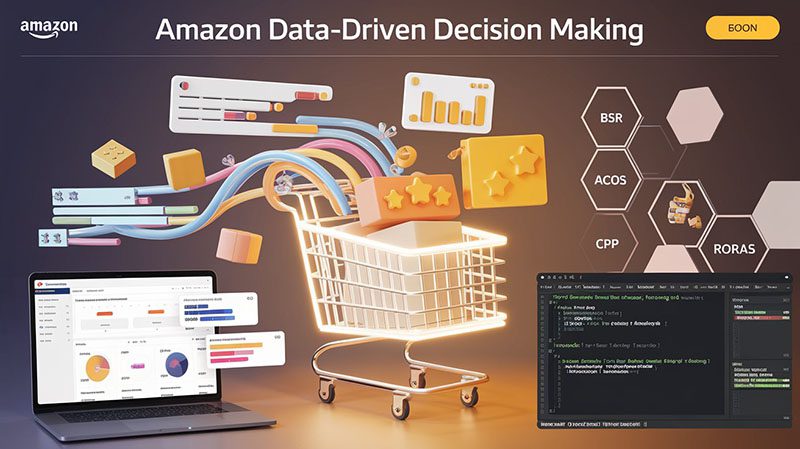Introduction: Surviving the Amazon Battlefield with Data
In 2023, Amazon hosts over 6 million active sellers globally, yet the top 10% of sellers contribute to 70% of the platform’s GMV (data from Marketplace Pulse). The key difference lies in data acquisition and processing capabilities—while ordinary sellers manually organize Excel sheets, top sellers have built real-time data pipelines through automated tools. This article dives deep into decision-making logic for product selection, advertising, and pricing, and addresses a critical question: Where are these life-saving data points hidden? How can they be captured without coding?
Part 1: Data-Driven Product Selection—From Red Ocean Battles to Blue Ocean Opportunities
1. The Golden Triangle of Market Trend Analysis
- BSR Ranking Deep Dive
Case Study: A home goods seller in Hangzhou analyzed BSR rankings for the “Home & Kitchen” category and found that foldable furniture’s share rose from 15% to 32% (January-June 2023). They targeted “expandable dining tables,” achieving 3,000+ sales in the first month.
Raw Data Requirements:- Category BSR rankings (including ASIN, price, review count)
- Historical ranking fluctuations (minimum 3-month span)
- Competitor Review Keyword Clouds
A pet product seller analyzed competitor reviews and discovered a 58% increase in mentions of “easy to clean,” prompting them to improve surface coatings, boosting conversions by 19%. - Market Entry Feasibility Model
Formula: Market Saturation = Top 10 Products’ Monthly Sales / Total Category Sales
Avoid entering if saturation > 65% (data from Amazon Brand Analytics).
2. Hidden Pitfalls in Profit Calculations
Common Mistake: A Guangzhou apparel seller failed to account for a 28% return rate, overestimating gross margin by 15%. Top sellers’ models must include:
- FBA fee breakdowns (down to packaging weight)
- Ad click costs (linked to keyword CPC data)
- Category-average return rates (extracted from Top 100 product reviews).
Part 2: Data-Driven Advertising—From Scattershot to Precision Targeting
1. Three-Dimensional Keyword Value Assessment
- Traffic Value: Search volume > 5,000/month
- Conversion Value: Avoid keywords where organic rankings exceed page 3
- Cost Value: CPC < 80% of category average
Case Study: A Shenzhen 3C seller reduced ACoS from 23% to 11% by targeting long-tail keywords like “bluetooth earphones for gym.”
Core Data Needs:- Keyword search volume (split by exact/broad match)
- Competitor ad placements (Sponsored Products monitoring).
2. Dynamic Ad Performance Optimization
A mother and baby seller implemented an “ACoS Tiered Response” system:
- Real-time tracking of keyword conversion rates
- Automatic pause for keywords with ACoS > 25%
- Daily ad performance heatmaps (tool: Pangolin Scrape API).
Part 3: Data-Driven Pricing—From Static Defense to Dynamic Warfare
1. Price Sensitivity Testing Model
Formula:
Price Elasticity Coefficient = % Change in Sales / % Change in Price
Case Study: A home goods seller tested:
- Price drop from 12.99→11.99: Sales rose 42% (elasticity = 1.8)
- Price hike from 12.99→13.99: Sales fell 35%
Result: A “base price + discount” strategy increased average order value by 22%.
2. Competitor Price Tracking Strategies
Tool Application: Use Scrape API to monitor competitor prices. Trigger 7-day flash sales when competitors’ inventory exceeds 500 units, forcing 3 rivals to exit the market.
Key Transition: Where Does the Data Come From?
After understanding the value of data-driven decisions, sellers face a fundamental question: How to efficiently capture BSR rankings, competitor ad keywords, and historical price trends? This is the Achilles’ heel for 90% of SMEs—relying on manual scraping or lacking technical resources.
Part 4: Data Tool Ecosystem—Democratizing Data Access
1. Zero-Code Solutions: Amazon Data Pilot
Step-by-Step Workflow:
- Create a Collection Plan: Select target regions (e.g., US zip code 90210, UK WC2N 5DU).
- Define Data Dimensions:
- By category ID (e.g., Home & Kitchen: 1055398)
- By BSR list URL
- By keyword (e.g., “foldable table”)
- Drag-and-Drop Fields:
- Basic fields: Price, review count, BSR rank
- Linked fields: Seller’s other product sales, Q&A hotspots
- Generate Reports: Export Excel files with sorting/filtering (auto-remove duplicate ASINs).
2. Advanced Customization: Pangolin Scrape API
High-Level Data Scraping Example:
# Scrape competitor ad keywords (replace API key)
import requests
headers = {"Authorization": "Bearer YOUR_API_KEY"}
params = {
"task_type": "sponsored_products",
"asin": "B08XYZ123",
"fields": "targeting_keywords,ad_positions",
"proxy": "residential" # Anti-blocking residential IP
}
response = requests.get('https://api.pangolin.com/v1/scrape', headers=headers, params=params)
print(response.json()) Tool Comparison:
| Feature | Data Pilot | Scrape API |
|---|---|---|
| Data Freshness | 24-hour updates | Real-time scraping |
| Field Customization | Predefined fields | Full-field access |
| Anti-Blocking | Auto-handled | Configurable proxy IPs |
| Use Case | Basic monitoring | Advanced advertising/pricing wars |
Conclusion: Transforming Data into a Strategic Radar
In an era where Amazon’s algorithms process thousands of transactions per second, sellers need their own data arsenal. Amazon Data Pilot and Pangolin Scrape API provide a “God’s-eye view”:
- Zero-Code Users: Configure BSR monitoring in 3 minutes, auto-updating daily.
- Technical Teams: Build competitor price trackers in 15 lines of code.
Act Now:
- [Get Data Pilot’s 7-Day Free Trial] (Includes price/review/BSR reports)
- [Claim Scrape API Test Package] (10,000 scrapes + residential IPs)
Final Insight:
“In the Amazon battlefield, data is the only strategist that never lies. Stop guessing—let tools unveil the full picture. From today, let data guide your growth.”
Appendix: Three-Step Implementation
- Diagnose Needs: Scan QR code for Amazon Data Health Assessment.
- Choose Tools:
- <100 SKUs → Data Pilot
- 3 categories → Scrape API
- Build Rhythm: Generate weekly reports every Thursday AM to align strategies.







